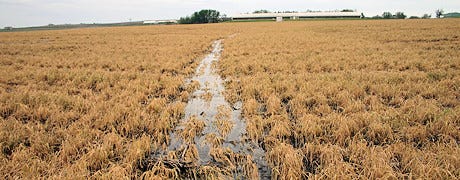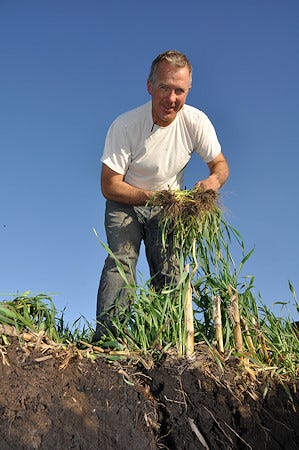February 19, 2013

By Lynn Betts
More farmers are taking a second look at the benefits of cover crops, but don't have much experience - or a good game plan. Iowa farmers Steve and Dennis Berger allowed us to tag along and offer up a visual calendar of how they manage cover crops from start to finish.
The Bergers plant corn and soybeans in April and May, but their production calendar begins in September. It's been that way ever since the two began using cover crops more than 10 years ago to save as well as build soil on their rolling hills and bottomlands near Wellman in eastern Iowa.

Runoff after a 3-inch rain in April of 2012 was clear. Erosion control and water infiltration are two of the Berger's primary reasons for using cover crops.
The cover crop veterans have been fine-tuning cover crops to the point that they can now get all their 2,000 acres of corn and soybeans planted to cereal rye after harvest, and sprayed in the spring.
"You have to get out there in the field with the drill the day you harvest," says Steve Berger. "You want as much growth in the fall as you can get, to establish roots below ground as well as plant cover above ground before winter."
Have something growing
"We like to have something growing on the land throughout the year as best we can, and we want it covered at all times," continues Berger. "We have cereal rye growing about seven months of the year. The top growth is there to control erosion, but the root mass below ground holds the soil in place, too.
"Rye's prolific root system goes as deep as 4 feet," Berger explains. "That not only opens the soil for air and water passage, it makes pathways that corn roots will follow deeper into the soil profile."
The growing roots also increase microbial action in the soil, he says, which builds organic matter and leads to better soil structure.

Cereal rye roots are key to holding Steve Berger's soil in place and building organic matter.
"Our busiest time of the year is September through December," says Steve. "We're harvesting corn and soybeans and planting cover crops simultaneously. We've planted cereal rye as late as November 1, but you don't get much beneficial growth after that."
Last year, they aerial-applied rye to 220 acres in early September. They have occasionally used an airplane and may do more of that to get earlier growth and to cut back on labor needs to drill rye.
In November, they also spread swine and turkey manure, and additional commercial potash. They also tile as much land as they can before the ground freezes.
They terminate the rye in the spring two to three weeks ahead of corn planting and apply starter fertilizer and insecticides at planting.
"We don't want to just maintain our soils, we want to build them. We're doing that slowly now with cover crops, no-till, hog manure, and tiling," Steve says.
The combination has resulted in corn yields consistently 30 bushels per acre above Washington County corn yield averages on soils with average corn suitability ratings for the county.
- Betts writes from Johnston, Iowa.
You May Also Like




